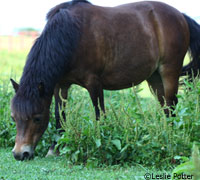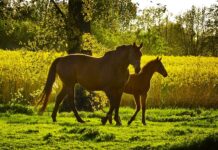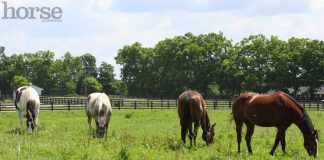 Q: I have a 10-month-old miniature colt and his 13-year-old mini companion turned out on about an acre of pasture. Is it safe to turn them out on fresh grass in the spring? How many hours can I keep them turned out on grass?
Q: I have a 10-month-old miniature colt and his 13-year-old mini companion turned out on about an acre of pasture. Is it safe to turn them out on fresh grass in the spring? How many hours can I keep them turned out on grass?
Laminitis, in its most basic description, is the inflammation and damage of the sensitive laminae inside a horse’s hoof. This laminae makes up the Velcro-like apparatus that attaches the coffin bone inside the hoof to the hoof wall outside – in essence, the coffin bone is suspended inside the hoof capsule by this laminae. This gives you an idea of how important the laminae are in order for a horse to actually stand and when there is damage to this vital structure, how painful and debilitating this damage can be.
Unfortunately, this sensitive laminae is very, well, sensitive. Incredibly susceptible to disruptions in metabolism and blood flow, these microscopic interdigitating tissues are easily upset and damaged in a host of ways. Sudden and dramatic alteration in feed intake, such as with grain overload and over-indulgence of rich spring grass cause whole body alterations in metabolism, with consequences in the feet. Other causes of laminitis include black walnut toxicity, retained placentas in mares, and excessive concussive forces on the feet, such as constant over-weight bearing on a single foot, as is sometimes the case during recovery from a leg fracture.
Due to the above listed causes of laminitis, it’s then no surprise that spring is a common time to see outbreaks of this condition, as horses are placed out on fresh, lush spring grass without restrictions and eat themselves into sickness. The high content of sugars in spring grass, in particular fructans, is a major culprit of laminitis, as the incomplete breakdown of these sugars in an overloaded digestive system can, in a very complex and non-intuitive way, actually cause disruption in microcirculation within the hoof. This results in oxygen starvation and subsequent breakdown of the sensitive laminae.
As with most health problems, prevention far outweighs treatment when it comes to dealing with laminitis. In the spring, it is imperative to restrict your horse’s intake of lush grass. The level of restriction will depend largely on the size of pasture, the density of the forage, the size of your horse, and how many other horses will be in the field. Conservatively, putting two minis out on one hour of grass a day is a good way to start. As their bodies become adjusted to this influx of rich grass, you can slowly keep them out for two hours, then three, etc. Your ending point will depend on how long the grass remains lush and if the minis are showing signs of weight gain. There are some cases where horses simply aren’t allowed on pasture twenty-four or even twelve hours a day because of the risk of laminitis. Ironically, the endless, richly green pasture horse owners envision in their dreams sometimes isn’t the healthy, ideal situation for their horses.
Another option to help decrease grass intake while still allowing your minis to enjoy the great outdoors is to fit them with grazing muzzles. These muzzles only have small openings where the horse will only be able to graze a few blades of grass at a time. Strip grazing can also gradually acclimatize a horse to new pasture.
Also keep in mind that miniature horses in general tend to be fairly “easy-keepers”, meaning that it doesn’t take much for these little guys to gain weight. Minis, ponies, and horses of the Quarter Horse-type seem to be more prone to weight gain, insulin resistance, and founder problems. Fatter horses are more prone laminitis, but that isn’t a guarantee that a lean horse can’t succumb to the condition as well.
Ask your horse training questions on the HorseChannel.com Forums >>
See more Expert Q&As >>
Submit your Ask the Expert question >>







very helpful! 2 months ago i became a 1st time mini owner, and this really helps with spring right around the corner. thanks!
I wish I had a dirt lot for my minis, but with the high prices of hay it seem counterintuitive.
That picture reminds me of one of my minis. It seems like minis get fat just looking at grass. In my opinion they are too-easy keepers.
We have a grazing muzzle for the mini at the barn, we have to be extra careful with him since his feet were horrifically grown out when we got him, so his coffin bones still aren’t where they should be.
I stake out the horses when spring grass grazing time comes, sort of like half an hour the first time, maybe twice a day, then a little longer, working up to one hour. then it is one hour, twice a day, then three times, etc.
Wow! That was very,very interesting!
Great advice. I’ve been letting my mini graze for about an hour at a time. Eventually I will let him graze for 2 but no more otherwise he’ll get fat in about 3 days.
I keep my two horses on pasture 24/7 and give Strategy daily. Since the horses are on pasture 24/7 do i still need to worry about this “early green ” flush of grass and lameness/
That was the best explanation of laminitus I think I have ever heard! Excellent article. Thank you.
We used to turn horses into a verdant pasture for a few hours at a time and then run them back out.My people thought that after being Wintered hay,brush and sack feed,horses should be introduced to that good green stuff little by little.
That was a really good description of laminitis. It is really good to know about things like that.
Very helpful!
Isn’t there also a time of day for spring grass that is more likely to cause problems? I have read too different opinions on this. One stated early morning until the sun has warmed up the grass was the worst time. The other said evening was the worst time. Does it matter?